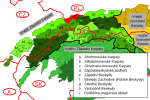Bielsko-Biala School of Finance and Law
1995 establishments in PolandBielsko-BiałaEducational institutions established in 1995Europe university stubsPolish school stubs
The Bielsko-Biala School of Finance and Law (Wyższa Szkoła Finansów i Prawa w Bielsku-Białej) is a school in Bielsko-Biała, Poland. It was founded in 1995 and gained its current name in 2011. Currently, the school offers courses in two departments and four different majors are: Finance, Information Technology, Law, and Internal Security.
Excerpt from the Wikipedia article Bielsko-Biala School of Finance and Law (License: CC BY-SA 3.0, Authors).Bielsko-Biala School of Finance and Law
Stanisława Skrzydlewskiego, Bielsko-Biała Aleksandrowice
Geographical coordinates (GPS) Address Nearby Places Show on map
Geographical coordinates (GPS)
| Latitude | Longitude |
|---|---|
| N 49.8134 ° | E 18.9989 ° |
Address
Wyższa Szkoła Finansów i Prawa
Stanisława Skrzydlewskiego
43-303 Bielsko-Biała, Aleksandrowice
Poland
Open on Google Maps










